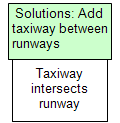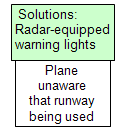Enterprising companies know that finding new, effective solutions to problems makes good business sense. Finding new solutions can be the difficult part. A root cause analysis can help find new, effective solutions. To demonstrate this capability, we’ll look at the problem of runway incursions at Los Angeles International Airport (LAX). In 2007, there were 21 incursions at LAX. Perhaps the problem was discussed, and it was determined that one of the causes of these incursions was that the taxiways intersected the runways. This is shown below in a Cause Map, or visual root cause analysis.

A potential solution, then, is to install a taxiway between the runways, so that they don’t intersect.

This solution has been implemented at LAX, with the result of runway incursions dropping to 5 so far this year. However, LAX officials would like that number to fall even further. So they started looking for new solutions. Finding new solutions may mean adding more detail to the Cause Map. For example, what if we add another cause for runway incursions?

This gives us another cause that we can try to “solve”. Here, the solution being implemented at LAX is radar-equipped warning lights. Essentially, if the system senses a plane or vehicle that could lead to a potential collision on a runway or taxiway, the runway lights turn red. If not, they are green. The plane still has to request clearance from traffic control, but it adds another layer of protection.

Officials at LAX hope this will continue to decrease the number of incursions at LAX. If not, the root cause analysis can be built into even more detail, and more solutions can be found.
